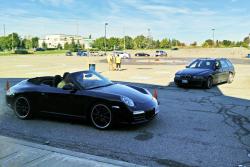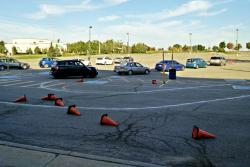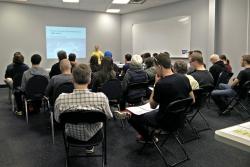Photos by Gary Grant and Andy Lin
UPDATE (May 4, 2015) – 2015 session dates for the Street Survival School are as follows:
May 31 – Seneca College (Finch/404)
Sept. 27 – Powerade Centre (Brampton)
Information & Registration: Tire Rack Street Survival School
Original article follows
I found myself standing in front of a box of Tim Hortons coffee at some ungodly hour on an early autumn Sunday morning. Purgatory: a long line of Tim Hortons catering containers, with people shuffling from coffee to donut to tea to cruller, forever and ever and ever, until the last Nickelback-laden radio wave fades away to nothing at the edge of the universe, or in this case, the hockey arena.
But if you’ll allow me the metaphor, that beige box of black liquid was more than just cardboard, it was a testament to the dedication of the organizers and volunteers who carted in supplies and gave up what would have made for a glorious track day to set up a closed course of a different kind. Welcome to the BMW and Porsche Clubs Tire Rack Street Survival School – improving the safety of our roads and highways, one driver at a time.
But first, a tech inspection. Unlike the cushy driving schools that Jonathan goes to where everything is Benzes and Porsches and seven-course dinners, here you’re rolling in your own daily driver. This is by design, because over the course of eight hours, you’re going to become intimately familiar with your vehicle as you push it until it breaks (traction). The tech inspectors look under the hood, check tire pressure, and examine the interior for any potential problems. Green sticker means you’re good to go.
The morning kicked off with what is officially termed Wake ’n’ Brake, or as I’d call it The ABS Experience (coming soon to a Cineplex near you). Everyone’s heard of anti-lock brakes, but most drivers have never felt it in action. The first time you have to slam on the brakes and the system kicks in, the sudden noise, vibration or change in pedal response can become a devastating distraction in an already stressful situation. Solution? Try out the ABS in a controlled environment.
Here, drivers accelerate toward a 10-metre lane marked by pylons. A lone orange cone stands at the end of the lane. The object is to stop before you hit the cone. Too simple, right? Well, some of these guys were still yawning into their coffees and it wasn’t long before an M3 trampled one of the plastic stalwarts. Boy racer aspirations, meet reality.
Each driver got several tries on the course, attacking it with ever more velocity and confidence. Despite the parade of vehicles roaring down the asphalt at maximum throttle and stopping precariously close to the marker, there was a surprising lack of noise and drama. Which is, of course, the point of the exercise. You might expect Hollywood-style brake squeal or tires screeching to a halt, but ABS is designed to prevent skids and allow steering control under hard braking. Theatrics, unfortunately, are not part of the equation. (Also, they were only accelerating for three seconds and these were Camrys and Fits, not Aventadors or Hellcats.)
   Tire Rack Street Survival School. Click image to enlarge |
Twenty minutes later, the combination of g-forces and caffeine had done the trick – the crowd gathered inside was bright-eyed and bushy-tailed. Martin Tekela – Porsche Club member, Young Drivers of Canada instructor and our MC – introduced the staff and the day’s program. Students were divided into groups, with half returning to their vehicles for one-on-one instruction, and the other half taking to the classroom. Shortly before we broke up, the inspection crew came in and announced that a third of the vehicles in the parking lot had tires that were dangerously underinflated. A scary statistic, considering that these vehicles would otherwise be on the road, their drivers completely oblivious.
My group started in the classroom with Mario Marrello, autocross chair for the Porsche Club. And one of the first things we learned: ABS doesn’t reduce your braking distance. In fact, it can even increase it. But what it provides in return is control of your vehicle when you need it most.












